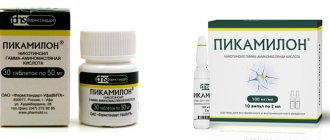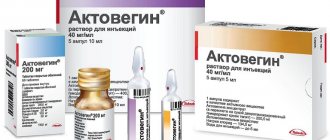Comparison of the effectiveness of Cipralex and Fevarin
Cipralex is more effective than Fevarin - this means that the ability of the drug substance to provide the maximum possible effect is different.
For example, if the therapeutic effect of Cipralex is more pronounced, then with Fevarin it is impossible to achieve this effect even in large doses.
Also, the speed of therapy is an indicator of the speed of the therapeutic action; Cipralex and Fevarin are also different, as is bioavailability - the amount of the drug reaching the site of its action in the body. The higher the bioavailability, the less it will be lost during absorption and use by the body.
Comparison of the effectiveness of Fevarin and Fluoxetine
The effectiveness of Fevarin is quite similar to Fluoxetine - this means that the ability of the drug substance to provide the maximum possible effect is similar.
For example, if the therapeutic effect of Fevarin is more pronounced, then using Fluoxetine even in large doses will not achieve this effect.
Also, the speed of therapy - an indicator of the speed of therapeutic action - is approximately the same for Fevarin and Fluoxetine. And bioavailability, that is, the amount of a drug reaching its site of action in the body, is similar. The higher the bioavailability, the less it will be lost during absorption and use by the body.
Comparison of safety of Cipralex and Fevarin
The safety of a drug includes many factors.
At the same time, it is higher for Cipralex than for Fevarin. It is important where the drug is metabolized: drugs are excreted from the body either unchanged or in the form of products of their biochemical transformations. Metabolism occurs spontaneously, but most often involves major organs such as the liver, kidneys, lungs, skin, brain and others. When assessing the metabolism of Cipralex, as well as Fevarin, we look at which organ is the metabolizing organ and how critical the effect on it is.
The risk-benefit ratio is when the prescription of a drug is undesirable, but justified under certain conditions and circumstances, with the obligatory observance of caution in use. At the same time, Cipralex has fewer risks when used than Fevarin.
Also, when calculating safety, it is taken into account whether only allergic reactions occur or possible dysfunction of the main organs. In other matters, as well as the reversibility of the consequences of using Cipralex and Fevarin.
Introduction
Obsessive-compulsive disorder (OCD), identified in the ICD-10 as a separate heading F-42, is one of the most common variants of borderline mental pathology. Its prevalence in the population is, according to various authors, 1.9–3.3% [1, 2], and its lifetime prevalence varies from 0.6 to 2.5% [3, 4].
OCD is slightly more common in women (1.5 times) than in men [5]. Typically, the average age of onset of the disease is 20 years with two peaks - at 12–14 years and 20–22 years. The prevalence of OCD is quite high among children, and if treatment is not provided, the disorder becomes continuous. There is a high comorbidity with other psychoneurological disorders, especially depression. In addition, in the group of patients with OCD there is a high incidence of suicidal behavior. The costs associated with treating this disease, taking into account the suffering of patients and the decrease in human resources for society, are estimated to be very high [5].
According to the ICD-10 criteria, a diagnosis of obsessive-compulsive disorder is established when obsessions or compulsive actions are experienced as excessive, irrational, intrusive and inappropriate; when it’s hard to give them up; when they cause distress, take up a lot of time, or interfere with daily activities. OCD is classified as an anxiety disorder because the sufferer's obsessions are the cause of severe anxiety, and the compulsions are aimed at preventing or alleviating it. Obsessions are persistent thoughts, ideas, impulses, or images that are repetitive, intrusive, and distressing. Compulsions are repeated and persistent behavioral or mental acts that people are forced to perform in order to prevent or reduce anxiety.
OCD is characterized by a chronic course associated with severe social maladjustment and disability. Until now, OCD is one of the mental disorders with a high level of resistance to psychopharmacotherapy.
In the treatment of OCD, the most widely used approach is based on modern ideas about the nature of this disorder - the theory of deregulation of serotonin metabolism. Based on this, many researchers postulate priority use of drugs with serotonergic effects, in particular serotonin reuptake inhibitors [6–10]. Controlled studies have not confirmed the effectiveness of drugs that lack this effect, for example, the classical tricyclic antidepressants nortriptyline, amitriptyline and desipramine, as well as MAO inhibitors [11].
One of the first serotonin reuptake inhibitors, clomipramine, has long been widely used as a primary antiobsessive drug. However, its use in many cases was complicated by the fact that to achieve an anti-obsessive effect, doses were required (3–4 times higher than antidepressant doses), which were fraught with an increased risk of adverse reactions [12–14]. Severe side effects (sedation, impaired concentration, weight gain, accommodation disorders, effects on urinary function, etc.) very often led to the patient changing the drug regimen to reduce the daily dose to an ineffective one.
This circumstance prompted the search for alternative methods of treating OCD. While clomipramine remains the “reference drug” for the treatment of OCD, newer generations of anxiolytic antidepressants are now more widely used.
Selective serotonin reuptake inhibitors (SSRIs), similar to clomipramine, have fairly high anti-obsessive activity, favorably differing from it in the lower incidence of adverse events [15–18]. The results of the vast majority of placebo-controlled and comparative studies confirm the undoubted effectiveness of SSRIs (fluvoxamine, sertraline, paroxetine, citalopram) in the treatment of OCD [17–22].
Despite the fact that comparative studies have established equal effectiveness of SSRIs and clomipramine, the rate of treatment discontinuation due to side effects of the latter (17%) is 2 times higher than among patients treated with SSRIs (about 9%) [23]. These factors are of particular importance for patients with OCD, who are expected to take drugs in high doses and for an almost unlimited time. Compared with clomipramine, which in high doses causes anticholinergic effects, increases the risk of seizures (up to 2%), has potentially dangerous cardiotoxicity and leads to weight gain, SSRIs are much better tolerated (Rasmussen, 1994).
Fluvoxamine is the drug of choice in the treatment of OCD
Fluvoxamine (Fevarin), being a typical representative of the SSRI class, is one of the “drugs of choice” in the treatment of OCD, as evidenced by data from numerous psychopharmacological studies (see table). It should be noted that in terms of anti-obsessive activity, Fevarin is not only superior to placebo, but is also comparable to the “standard” anti-obsessive drug - clomipramine. Fevarin has advantageous differences from tricyclic antidepressants that do not have serotonergic activity. According to the cited studies, fluvoxamine (Fevarin) is characterized by a more favorable side effect profile, which allows us to count on the safety of long-term therapy using high daily doses.
Summarizing the data from studies of the effectiveness of fluvoxamine in the treatment of OCD, it is necessary to dwell on a number of features of its use (characteristic of other SSRIs). The anti-obsessive effect of fluvoxamine is difficult to detect during the 1st week of therapy. Most patients taking the drug experience slow, gradual improvement over weeks or months. It should be borne in mind that low doses of Fevarin (50–100 mg/day) do not lead to a reduction in obsessive-compulsive symptoms. To date, a direct relationship between the severity of the reaction and the dose of the drug has been established. In the presence of comorbid affective disorders, depressive symptoms are reduced at an earlier stage, and only after this do ideational and motor obsessions undergo a reverse development.
The process of reduction of obsessive-compulsive symptom complexes reaches a plateau within several weeks, regardless of the dose. In contrast to the treatment of panic disorder, the use of fluvoxamine for OCD in the first days of therapy is not associated with increased anxiety. Since high doses are associated with increased severity of side effects, it is recommended to start treatment with a lower dose and gradually increase it over several weeks or even months, depending on the clinical dynamics. The relationship between the rate of improvement and tolerability of the drug should be taken into account.
In some cases (20%, according to Fineberg N. [5]), a delayed therapeutic response is detected when a reduction in obsessive-compulsive symptoms is recorded after several months of therapy. In general, it is advisable to continue treatment for at least 3 months to allow the therapeutic effect to occur. The anti-obsessive effect lasts as long as treatment continues. Accordingly, long-term therapy avoids relapses of obsessive-compulsive symptoms. In addition, over time, the severity of side effects decreases, which also helps to improve the condition of patients [5].
Fluvoxamine's good tolerability and relatively low rate of premature discontinuation (compared to clomipramine) provide the best treatment for OCD, confirming its value as the drug of choice. Clomipramine remains a second-line drug, which is advisable to use in cases of intolerance or ineffectiveness of SSRIs or when parenteral therapy is necessary.
Features of the use of fluvoxamine in children and adolescents
Studies of the effectiveness of fluvoxamine (Fevarin) in the treatment of OCD in childhood and adolescence, although not numerous, nevertheless provide an idea of the validity of the use of the drug in this patient population. Based on the fact that the manifestation of OCD often occurs in childhood and adolescence, early initiation of therapy may contribute to a more favorable prognosis of the disease as a whole.
Fluvoxamine is actively used in child and adolescent psychiatry, both in isolation [21] and in combination with psychotherapy (mainly behavioral) [22]. According to Neziroglu F. et al. [22], the use of fluvoxamine in conjunction with behavioral psychotherapeutic techniques significantly enhances the therapeutic effect. The authors especially emphasize the safety of using the drug in children and adolescents.
As evidenced by the publication of Voloshin V.M. and Shilova A.M. [21], Fevarin proved to be effective when used in child and adolescent psychiatric practice. The authors state its pronounced psychopharmacological effect in relation to OCD of various origins in children and adolescents, as well as in the treatment of depressive states without psychotic symptoms, but with the presence of compulsions and obsessions in the psychopathological structure (79 observations in total). According to the authors, the range of clinical effects of fluvoxamine allows us to consider it as an antidepressant with a highly balanced psychopharmacotherapeutic effect, characterized by distinct anxiolytic, anti-obsessive and vegetostabilizing effects. The revealed high level of drug safety allowed us to recommend it for the treatment of OCD in children and adolescents.
Fluvoxamine in the treatment of OCD in somatic practice
One of the interesting aspects in the treatment of OCD is the possibility of using fluvoxamine (Fevarin) for combined mental and somatic pathologies. The greatest problem is presented by obsessive-compulsive symptom complexes associated with self-harming behavior.
This problem most acutely concerns OCD associated with self-destructive dermatoses (primarily neurotic excoriations). Despite the fact that the experience with the use of SSRIs in this variant of OCD is very limited [23, 24], a trend has emerged suggesting that they are the drugs of choice in the treatment of neurotic excoriations.
In this regard, it is appropriate to cite data from a recently completed domestic study carried out at the Clinic of Skin Diseases of the MMA named after. THEM. Sechenov [25]. In this work, the clinical picture of OCD with self-harm of the skin was determined by the obsessive desire to scratch “pathological” areas of the skin in order to relieve internal tension. Patients in the studied sample scratched, squeezed or pinched their skin. In most cases, self-harm was inflicted with nails, less often with a needle, tweezers or blade; sometimes cauterizing liquids (iodine, an alcohol solution of brilliant green, a concentrated solution of potassium permanganate) were additionally used. Temporary relief was noted only after self-harm, when the skin was strongly scratched and all the scabs were torn off. Based on the results of using Fevarin monotherapy, 24 out of 30 patients completed the full course of treatment. The clinical effect was noted already by the middle of the 2nd week of therapy. Positive dynamics were recorded in 15 out of 24 patients (62%). Among patients with obsessions, the proportion of responders was 64.2%. The researchers noted a favorable tolerability profile of the drug, with adverse events reported in only three patients. Palpitations, tremor, difficulty falling asleep, and difficulty concentrating in these cases were moderately pronounced and were completely reduced with the additional administration of benzodiazepine derivatives (0.5–1 mg/day phenazepam or clonazepam). When assessing the effect of Fevarin in combination with traditional dermatological treatment on the dynamics of the skin status of patients in the studied sample, no clinically significant interactions between the drug and dermatological agents were registered. The authors concluded that Fevarin is highly therapeutic for OCD in patients with dermatological symptoms. With its use, there is a significant improvement not only in the mental, but also in the dermatological status of patients. The results of the study confirm the feasibility of using fluvoxamine in the treatment of OCD with self-harm of the skin.
These data correlate with the results of an earlier study by Arnold L. [23], who used fluvoxamine in 34 patients with neurotic excoriations. The results obtained indicate the high effectiveness and safety of fluvoxamine in the treatment of obsessive (neurotic) excoriations.
Methods of combined use of fluvoxamine
Although SSRI monotherapy achieves significant improvement in the majority of patients with OCD, in a significant proportion of patients the achieved remission is not complete. In approximately 30% of cases, despite long-term use of SSRIs, residual, discomforting symptoms remain. The problem of incomplete response to treatment raises the question of the legitimacy of using “enhancement strategies.”
Factor analysis of data from various studies shows that the best results are observed in patients who have previously undergone behavioral (but not drug) therapy, suffering from severe forms of OCD, as well as with concomitant depression [5].
Various strategies can be used to treat patients with incomplete response to interventions. Clinical experience allows us to insist on continuing treatment with SSRIs even in a group of patients with minimal signs of improvement, since even 6 or more months after the start of treatment, a delayed positive reaction may develop.
The results of uncontrolled observations indicate that in some cases increasing the dose may lead to the desired result. It is hardly worth recommending a combination of a drug from this group with clomipramine. Moreover, in the case of such a combination, it is necessary to monitor the concentration of drugs in the blood serum, since their pharmacokinetic interactions and the dependence of metabolism on the activity of hepatic cytochrome P450 isoenzymes can lead to dangerous accumulation of clomipramine.
Currently, several dosage escalation regimens have been proposed, but all of them are based on the results of small studies, so evidence of the effectiveness of each of them is insufficient. When treating patients with a partial response to fluvoxamine monotherapy, low doses of typical antipsychotics (about 0.5–3.0 mg haloperidol) added to an SSRI may be useful [9].
Newer, atypical antipsychotics are not as effective. Although some studies have shown that risperidone in combination with an SSRI improves the effectiveness of treatment of drug-resistant cases, other studies suggest that the combination actually worsens the condition of patients. Clozapine use is associated with worsening obsessive-compulsive symptoms. Reports of the effectiveness of the use of SSRIs in combination with buspirone have not been confirmed in controlled studies [28].
To date, there has been an understanding of very limited indications for the use of benzodiazepine derivatives in OCD [9, 10, 29, 30]. Most researchers are inclined to believe that drugs of this pharmacological class can be used primarily as part of combined therapeutic techniques (as additional drugs in SSRI therapy). At the same time, the indications for the use of this type of technique remain insufficiently developed *.
As for the inclusion of anxiolytics in therapeutic regimens, it is justified:
- in the presence of pronounced manifestations of anxiety in the structure of OCD [9, 28, 29];
- when used as correctors for the side effects of SSRIs (insomnia, increased anxiety, agitation, etc.) [9, 31];
- in cases where it is impossible to use SSRIs in adequate doses (for somatic diseases, for hypersensitivity to the drug used) [9, 29];
- to overcome resistance to the main anti-obsessive drugs [9, 10 33, 34].
Modern principles of the use of antipsychotics in the treatment of OCD suggest their inclusion in the therapeutic regimen only in cases of obvious resistance to the main SSRIs [9].
Another indication for the use of antipsychotic drugs is an atypical clinical picture of OCD, for example:
- the presence in the structure of the syndrome of erased hallucinatory-delusional manifestations [9];
- the presence in the structure of the syndrome of catatonic motor disorders (motor stereotypies, tics) [1, 6, 20, 35–37];
- comorbidity with schizophrenia [38];
- comorbidity with severe personality disorders (personality disorders of cluster “A” DSM-IV – paranoid, schizoid, schizotypal) [9, 27].
There is no evidence yet that the use of lithium in combination with SSRIs achieves better results. The effectiveness of electroconvulsive therapy in the treatment of drug-resistant OCD also remains unproven.
Conclusion
Concluding the analysis of studies on the effectiveness of fluvoxamine (Fevarin) for various types of OCD, we should dwell on some practical recommendations.
The starting dose of the drug (as in the treatment of depression and other anxiety disorders) is 50 mg/day. After 3–4 days of therapy, the daily dosage is selected individually. The effective dose is usually in the range of 100–300 mg/day. The dose is increased gradually until a therapeutically effective level is reached. The maximum daily dose for adults is 300 mg, for children - 8 years old and adolescents - 200 mg. The drug in a dose of up to 150 mg is taken once a day, preferably in the evening. A daily dose of more than 150 mg should be divided into two to three doses.
When a pronounced therapeutic effect is achieved, it is necessary to continue therapy at an individually selected dose. If treatment fails within 10 weeks, fluvoxamine therapy should be reconsidered. Since there is no systematic data on the recommended duration of treatment for OCD with fluvoxamine, given the chronic course of this disorder, therapy should be continued beyond 10 weeks in patients with a good clinical response to the drug. The dose must be selected with caution, individually for each patient; To avoid undesirable effects, maintenance therapy should be carried out with the minimum effective dose of the drug. In patients with renal and hepatic insufficiency, therapy should begin with lower doses of the drug, and careful monitoring of their condition is also necessary.
Fluvoxamine (Fevarin) is the drug of choice for the treatment of OCD, but it should be taken into account that obsessive-compulsive symptom complexes are among the disorders with a high level of treatment resistance. Consequently, monotherapy strategies are not always highly effective. In cases of obvious drug resistance (under conditions of an adequate dosage regimen and compliance with the terms of therapy), it is appropriate to combine fluvoxamine with drugs of other pharmacological groups. To date, the safety of combined techniques is beyond doubt - no significant interactions have been established between SSRIs and other drugs. The only exceptions are reversible and irreversible MAO inhibitors.
* T. Pigott et al. (1992), stating the low effectiveness of the “clonazepam + buspirone” regimen, emphasize that among OCD there is a group of little-studied conditions in which such an approach may be justified.
Comparison of addiction between Cipralex and Fevarin
Like safety, addiction also involves many factors that must be considered when evaluating a drug.
So, the totality of the values of such parameters as “syndrome o” in Cipralex is quite similar to the similar values in Fevarin. Withdrawal syndrome is a pathological condition that occurs after the cessation of intake of addictive or dependent substances into the body. And resistance is understood as initial immunity to a drug; in this it differs from addiction, when immunity to a drug develops over a certain period of time. The presence of resistance can only be stated if an attempt has been made to increase the dose of the drug to the maximum possible. At the same time, Cipralex has a fairly low “syndrome” value, just like Fevarin.
Comparison of side effects of Fevarin and Fluoxetine
Side effects or adverse events are any adverse medical event that occurs in a subject after administration of a drug.
Fluoxetine has more adverse effects than Fevarin. This implies that the frequency of their occurrence is low with Fluoxetine and low with Fevarin. Frequency of manifestation is an indicator of how many cases of an undesirable effect from treatment are possible and registered. The undesirable effect on the body, the strength of influence and the toxic effect of drugs are different: how quickly the body recovers after taking it and whether it recovers at all. When using Fluoxetine, the body's ability to recover faster is higher than that of Fevarin.
Comparison of side effects of Cipralex and Fevarin
Side effects or adverse events are any adverse medical event that occurs in a subject after administration of a drug.
Cipralex has almost the same level of adverse events as Fevarin. They both have few side effects. This implies that the frequency of their occurrence is low, that is, the indicator of how many cases of an undesirable effect of treatment are possible and registered is low. The undesirable effect on the body, the strength of influence and the toxic effect of Cipralex are similar to Fevarin: how quickly the body recovers after taking it and whether it recovers at all.
Fevarin (Fluvoxamine)
Contraindications
Severe liver dysfunction, simultaneous use of MAO inhibitors, children under 8 years of age, hypersensitivity to fluvoxamine.
Dosage
Installed individually. At the beginning of treatment, the daily dose is 50-100 mg (recommended to be taken at night). If there is insufficient effectiveness, the daily dose can be increased to 150-200 mg. The maximum daily dose is 300 mg. If the daily dose is more than 100 mg, then it should be divided into 2-3 doses.
According to official WHO recommendations, treatment with antidepressants should be continued for at least 6 months after the depressive episode has resolved.
Side effects
From the digestive system: often - nausea, sometimes accompanied by vomiting (usually disappears in the first 2 weeks of treatment); possible - constipation, anorexia, dyspepsia, diarrhea, discomfort in the epigastric region, dry mouth, discomfort; rarely - increased activity of liver enzymes, mainly in elderly patients - transient hyponatremia (in some cases caused by the syndrome of inappropriate ADH secretion, disappears after discontinuation of fluvoxamine).
From the side of the central nervous system: possible drowsiness, dizziness, headache, insomnia, anxiety, psychomotor agitation, fear, tremor, discomfort, asthenia; After abrupt withdrawal of fluvoxamine, headache, nausea, dizziness, and a feeling of fear were observed in rare cases.
From the cardiovascular system: a slight decrease in heart rate (by 2-6 beats/min), a feeling of palpitations, tachycardia is possible.
Other: possible increased sweating, changes in body weight.
Some of the side effects listed above may be symptoms of depression and are not caused by fluvoxamine.
Drug interactions
When used simultaneously with MAO inhibitors, there is a possibility of developing serotonin syndrome, especially when used simultaneously with irreversible, non-selective MAO inhibitors.
With simultaneous use, the plasma concentration of alprazolam, bromazepam, diazepam increases and their side effects increase due to the fact that fluvoxamine inhibits the metabolic processes of these benzodiazepines.
With simultaneous use, the plasma concentration of amitriptyline, clomipramine, imipramine, maprotiline, trimipramine increases, which is apparently due to the fact that fluvoxamine is a non-competitive inhibitor of the CYP1A2 isoenzyme, with the participation of which the process of N-demethylation of these antidepressants occurs.
When used simultaneously with buspirone, its effectiveness may decrease; with valproic acid - the effects of valproic acid may be enhanced; with warfarin - there may be an increase in the concentration of warfarin in the blood plasma and a risk of bleeding; with galantamine - the likelihood of increased side effects of galantamine increases; with haloperidol - the concentration of lithium in the blood plasma increases.
With simultaneous use, the concentration of carbamazepine in the blood plasma increases, which is due to inhibition of its metabolism in the liver, mainly due to the suppression of the activity of the CYP2D6 isoenzyme under the influence of fluvoxamine.
With simultaneous use, the concentration of clozapine in the blood plasma significantly increases, which in some patients is accompanied by the development of toxic effects of clozapine.
With simultaneous use, caffeine clearance may be reduced and its effects may be enhanced. This interaction is due to the fact that fluvoxamine significantly inhibits the CYP1A2 isoenzyme, which is the main enzyme responsible for the metabolism of caffeine.
When used simultaneously with metoclopramide, a case of the development of extrapyramidal disorders has been described.
When used simultaneously with olanzapine, the concentration of olanzapine in the blood plasma increases; with propranolol - the concentration of propranolol in the blood plasma increases, which is apparently due to the inhibition by fluvoxamine of isoenzymes of the cytochrome P450 system involved in the metabolism of propranolol.
When used simultaneously with theophylline, the concentration of theophylline in the blood plasma increases, which leads to the development of toxic reactions. This interaction is due to the fact that fluvoxamine significantly inhibits the CYP1A2 isoenzyme, which is the main enzyme responsible for the metabolism of theophylline.
With simultaneous use, the clearance of tolbutamide and its metabolites decreases, which is due to inhibition of the CYP2C9 isoenzyme.
There are isolated reports of increased side effects of phenytoin when used simultaneously with fluvoxamine.
With simultaneous use, metabolism slows down and clearance of quinidine decreases.
special instructions
With depression, there is usually a high likelihood of attempting suicide, which may persist until sufficient remission is achieved.
Use with caution in patients with a history of seizures. If an epileptic seizure develops, treatment with fluvoxamine should be discontinued.
In patients with hepatic or renal insufficiency, fluvoxamine should be prescribed in low doses at the beginning of treatment under close medical supervision.
If symptoms due to increased liver enzyme activity occur, fluvoxamine should be discontinued.
In elderly patients, the dose of fluvoxamine should always be increased more slowly and with greater caution.
There are reports of the development of ecchymosis and purpura with the use of selective serotonin reuptake inhibitors. Given this, such drugs should be prescribed with caution, especially concomitantly with drugs that affect platelet function (for example, with atypical antipsychotics and phenothiazines, many tricyclic antidepressants, NSAIDs, including acetylsalicylic acid), as well as in patients with a history of bleeding.
During the treatment period, alcohol consumption is not allowed.
Due to the lack of clinical experience, fluvoxamine is not recommended for the treatment of depression in children.
Impact on the ability to drive vehicles and operate machinery
In patients whose activities require concentration and high speed of psychomotor reactions, fluvoxamine should be used with caution until the individual response to treatment is finally determined.
Treatment with MAO inhibitors should be discontinued 2 weeks before starting fluvoxamine.
Fluvoxamine may slow down the elimination of drugs metabolized by liver microsomal enzymes.
Pregnancy and lactation
If it is necessary to use fluvoxamine during pregnancy, the expected benefits of therapy for the mother and the possible risk to the fetus should be assessed.
Fluvoxamine should not be used during lactation, because... This active substance is excreted in small quantities in breast milk.
Use in childhood
- Contraindicated in children under 8 years of age.
- For impaired renal function
- In patients with renal failure, fluvoxamine should be prescribed in low doses at the beginning of treatment under close medical supervision.
- For liver dysfunction
- Contraindicated in cases of severe liver dysfunction.
- In patients with hepatic impairment, fluvoxamine should be administered in low doses at the beginning of treatment under close medical supervision.
- If symptoms due to increased liver enzyme activity occur, fluvoxamine should be discontinued.
Use in old age
In elderly patients, the dose of fluvoxamine should always be increased more slowly and with greater caution.
Comparison of ease of use of Cipralex and Fevarin
This includes dose selection taking into account various conditions and frequency of doses. At the same time, it is important not to forget about the release form of the drug; it is also important to take it into account when making an assessment.
The ease of use of Cipralex is approximately the same as Fevarin. However, they are not convenient enough to use.
The drug ratings were compiled by experienced pharmacists who studied international research. The report is generated automatically.
Last update date: 2020-12-13 10:32:12









